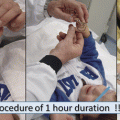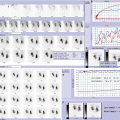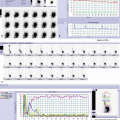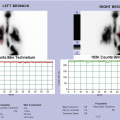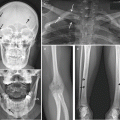© Springer International Publishing Switzerland 2017
Maria Carmen Garganese and Giovanni Francesco Livio D’Errico (eds.)Conventional Nuclear Medicine in Pediatrics10.1007/978-3-319-43181-9_1414. Gastroenterology: Focus on Children with Gastrointestinal Problems
(1)
Unit of Endoscopic Surgery, “Bambino Gesù” Children Hospital, Rome, Italy
Gastrointestinal imaging tests are a cornerstone of the gastroenterologist’s diagnostic armamentarium. Over the last decades, nuclear medicine has gained increasing importance for the assessment of the digestive system disorders.
Since the first description of a radiolabeled meal administration in 1966, scintigraphy has become the standard test to measure the gastric emptying; however, despite promising results, no other significant progress in clinical practice has been made for studying gastrointestinal motility [10].
By definition, gastroparesis is a gastric motility disorder characterized by delayed gastric emptying without evidence of mechanical obstruction [3]. In adults, diabetic, postsurgical, and idiopathic etiologies account for approximately one third each of cases. In children, the majority of cases are idiopathic [15].
Classically, symptoms of gastroparesis include abdominal pain, nausea, vomiting, abdominal fullness, and early satiety. These are complaints commonly seen in pediatric clinical practice and may be found in other etiologies. Therefore, the diagnostic workup should include an upper gastrointestinal contrast study or an esophagogastroduodenoscopy in order to rule out mechanical obstruction or other organic underlying disorders (e.g., esophagitis and peptic ulcer disease). Once anatomical or organic diseases are excluded, gastroparesis and functional dyspepsia (defined by the Rome III criteria) can be considered; indeed, there is a significant clinical overlap between them. Moreover, it has been shown that a subset of children with clinical diagnosis of functional dyspepsia has a delayed gastric emptying [4].
Gastric emptying scintigraphy is the most reliable method to make a diagnosis of gastroparesis. It provides a noninvasive, physiological, quantitative measurement of gastric emptying. Especially in infants and in neurologically impaired children, a gastric emptying study may also be indicated for patients with refractory symptoms of gastroesophageal reflux disease, since gastroparesis may contribute or aggravate gastroesophageal reflux symptoms [11].
Identifying patients with delayed gastric emptying is important in treatment decision-making.
According to the symptoms’ severity and based on scintigraphy results, the management may include dietary modification, pharmacological therapy, and endoscopic or surgical approaches [2, 15].
A field of very useful scintigraphic application is the assessment of the oropharyngeal and esophageal motor function. A complex coordination of sequences, controlled by multiple levels of the nervous system, is required for a safe and efficient swallowing. The phases of the swallowing process allow the normal bolus propulsion from the mouth to the stomach, avoiding the passage of food through the larynx into the respiratory tree. Oropharyngeal dysphagia can be caused by disorders of the central nervous system (e.g., cerebral palsy) and by neuromuscular diseases. Pulmonary aspiration during feeding is an important cause of acute, recurrent, and chronic pulmonary disease in children [18]. Moreover, during gastroesophageal reflux episodes, when the refluxate does enter the pharynx, the airway is protected by reflexive glottal closure and a pharyngoglottal closure reflex; impairment in this mechanism may result in aspiration. Infants who are born preterm, those that are small for gestational age, and those with cerebral palsy are at greatest risk of developing pharyngeal and/or esophageal motility disorders [16].
After an accurate patient’s history and clinical assessment, instrumental testing is necessary for definitive diagnosis of swallowing dysfunction and aspiration. Videofluoroscopic swallow study and fiber-optic endoscopic evaluation of swallowing are the most commonly used tools, but nuclear scintigraphy may play an important role in aspiration assessment. As previously stated, aspiration can occur either during swallowing (antegrade) or as retrograde aspiration of gastric or esophageal contents [14]. The radionuclide salivagram primarily detects aspiration during swallowing (antegrade events), and the gastroesophageal reflux scintigraphy (“milk scan”) is more likely to detect events related to gastroesophageal reflux (retrograde events). During both tests, aspiration diagnosis is made when radiopharmaceutical activity is detectable within the lung fields [1]. Gastroesophageal scintigraphy scanning can detect reflux episodes occurring during meals administration and/or during study registration (at least 1 h) independently of the gastric pH; consequently, late postprandial acid exposure and occurrence of reflux episodes are missed with scintigraphy. The number of reflux episodes, level reached within the esophagus, and the clearance rate of reflux episodes may then be determined by scintigraphy. However, a lack of standardized techniques and the absence of age-specific norms are important limits of the test in the assessment of the gastroesophageal reflux disease [19].
Although not as well standardized as gastric emptying scintigraphy, esophageal transit scintigraphy may provide a quantitative and qualitative analysis of single- and multiple-swallow studies. Esophageal manometry is the standard test in assessing esophageal motility; however, when it is not available or results are equivocal, esophageal scintigraphy can be clinically useful. The transit time and/or retention in the esophagus can be assessed by scintigraphy. Scintigraphy studies of esophageal transit have shown a high sensitivity for detecting a wide range of esophageal disorders (e.g., achalasia, diffuse esophageal spasm, scleroderma), but a lower sensitivity, especially for disorders with intact peristalsis but high-amplitude contractions or isolated elevated pressures in the lower esophageal sphincter. Despite specific criteria for diagnosing the primary esophageal motility disorders have been proposed (in adults), its clinical utility in clinical practice is not well defined, and its widespread use is still limited [11].
As far as gastrointestinal motility is concerned, nuclear medicine efforts are channeled toward the standardization of small bowel and colon transit studies. Scintigraphy is a safe and noninvasive method for the quantitative evaluation of overall and regional intestinal transit. Scintigraphic test also allows the possibility to study gastric emptying and whole bowel transit as part of the same study. Indications for small bowel and colon transit scintigraphy include dyspepsia, irritable bowel syndrome, chronic constipation, chronic diarrhea, and chronic idiopathic intestinal pseudo-obstruction [12]. A partial, but encouraging, success in advancing gastrointestinal scintigraphy was achieved through the development of methods for the study of the colonic transit [13]. Compared to traditional tests (e.g., radiopaque markers), disadvantages of the colonic scintigraphy are related to the lack of standardization, especially in children, and its limited availability due to high costs and need for specialized equipment. However, radiolabeled meal allows a more physiological radioisotope incorporation into the gut content compared with the indigestible solid pellet. In 2005, a task force committee on gastrointestinal transit studies has stated that “the scintigraphic method is the only one that reliably allows the determination of both total and regional transit times” [9].
Stay updated, free articles. Join our Telegram channel

Full access? Get Clinical Tree



